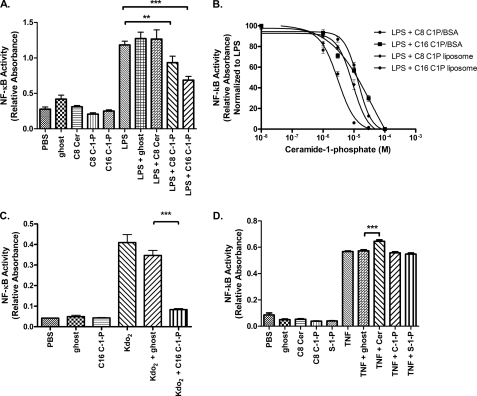FIGURE 1.
Ceramide-1-phosphate limits TLR4-mediated NF-κB activity, as measured by a SEAP reporter assay. A, ceramide-1-phosphate, but not ceramide, limits LPS-mediated NF-κB activation. HEK TLR4 cells transfected with the SEAP reporter vector were treated for 24 h with a 10 μm concentration of the indicated liposomal lipids with or without 100 ng/ml LPS. Ghost liposome serves as a vehicle control. Relative absorbance is a proxy for NF-κB-mediated transcription. B, inhibition of NF-κB activity is independent of the C-1-P delivery method and chain length. HEK TLR4 cells stably transfected with the SEAP reporter vector were treated for 24 h with 100 ng/ml LPS and varying concentrations of either liposomal C-1-P or C-1-P-BSA carrier. Relative absorbance normalized to LPS treatment is displayed as a function of C-1-P concentration and delivery method. IC50 was determined by GraphPad Prism 5 software using variable fit nonlinear regression. C, C-1-P inhibits Kdo2-lipid A-mediated NF-κB activation. HEK TLR4 cells stably transfected with the SEAP reporter vector were treated for 24 h with 1 μg/ml Kdo2-lipid A and/or liposomal 10 μm C16 C-1-P or lipid mass equivalent ghost liposome control. D, C-1-P does not affect NF-κB activation by TNF-α. HEK TLR4 cells stably transfected with the SEAP reporter vector were treated for 24 h with 100 ng/ml TNF-α and/or 10 μm liposomal lipids. Error bars, S.E. *, p < 0.05; **, p < 0.01; ***, p < 0.001. All experiments include a minimum of six replicates and were performed on at least three separate occasions.

